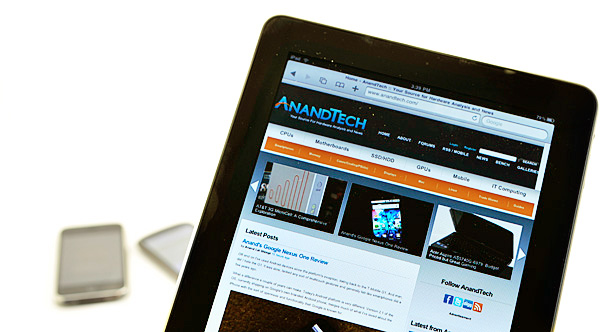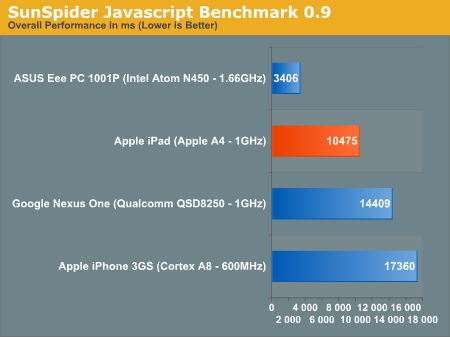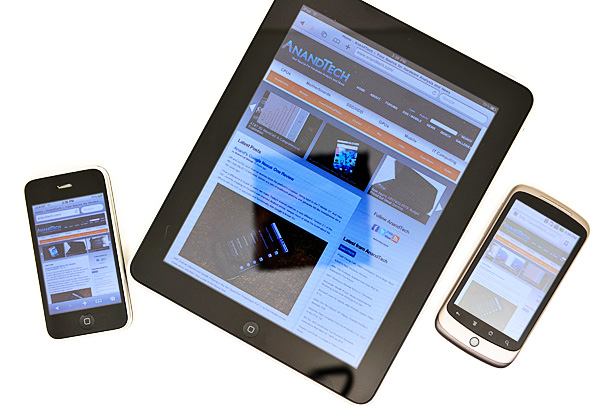Apple's iPad A4 SoC: Faster than the Nexus One's Snapdragon?
by Anand Lal Shimpi on April 3, 2010 3:52 PM EST- Posted in
- Smartphones
- Mobile
Fresh out the frying pan and into the fire, I just finished my Nexus One review late last night only to have my iPad preorder show up early this afternoon. I had been preparing for it's arrival not by downloading apps but by figuring out what comparative benchmarks I wanted to run on the iPhone 3GS and Nexus One.

As the first device to use Apple's A4 SoC I wanted to see how it stacked up against the Cortex A8 and Qualcomm's QSD8250. All three chips appear to be dual issue in order architectures with varying pipeline depths, clock speeds and cache sizes.
At 600MHz the Cortex A8 in the iPhone 3GS is the slowest out of the bunch. The Snapdragon is much faster as we just established thanks in part to it's 1GHz clock speed. But what about Apple's 1GHz A4?

There's very little we know about the A4 other than it's operating frequency. It is manufactured by Samsung but on an unknown process node. Jon Stokes recently stated that Apple's secrecy surrounding the chip is because it isn't anything special, just a Cortex A8. If that is true, I suspect that it would have to be manufactured at 45nm in order to reach such a high clock speed.
With a new silicon mask there's also the chance that Apple moved to LPDDR2 to boost memory bandwidth; a change that most SoC makers are planning to make this year.
So how does Apple's A4 stack up against today's favorite smartphone brainchild? Keep in mind that these results are generated by running two different OSes (Android 2.1 and iPhone OS 3.2) and two different browsers. What we're looking at is the performance delivered by the combination of the CPU and the software stack:
| Applications Processor Performance | ||||||
| Apple iPad (Apple A4) | Apple iPhone 3GS (ARM Cortex A8) | Google Nexus One (Qualcomm Snapdragon QSD8250) | % A4 Faster than Snapdragon | |||
| Load www.anandtech.com | 6.2 seconds | 9.3 seconds | 8.8 seconds | 41% | ||
| Load www.digg.com | 10.6 seconds | 18.0 seconds | 11.5 seconds | 8.7% | ||
| Load www.tomshardware.com | 7.9 seconds | 13.9 seconds | 8.6 seconds | 8.7% | ||
| Load www.arstechnica.com | 7.8 seconds | 13.8 seconds | 11.0 seconds | 39.9% | ||
| Load www.legitreviews.com | 6.8 seconds | 12.3 seconds | 8.6 seconds | 26% | ||
| Load www.techreport.com | 3.7 seconds | 7.4 seconds | 4.2 seconds | 11.6% | ||
| Load www.engadget.com | 13.8 seconds | 22.8 seconds | 22.0 seconds | 59.4% | ||
| Load www.gizmodo.com | 14.1 seconds | 21.4 seconds | 16.7 seconds | 18.5% | ||
| Load m.cnn.com | 3.0 seconds | 6.0 seconds | 2.6 seconds | -11.8% | ||
Unless otherwise specified, I loaded the full version of all of the websites above (the exception being CNN, where I used the mobile site). To ensure reliability, I ran all of these tests at least 5 times, threw out any outliers and averaged the rest. The rests were also run at around the same time to ensure that content on the sites was as similar as possible (and thus shouldn't be compared to this morning's Nexus One results). You'll note that the Engadget results are a bit odd. It looks like the iPhone and Nexus One scores are bottlenecked somewhere else (there seemed to be some network issue plaguing the loads, but it wasn't present on the iPad), but if you toss out the very large differences you end up with what I believe to be the real story here. Update: Flash wasn't enabled on any device (not supported on iPad/iPhone, not officially available on Android yet), and all three devices connected to the same WiFi network. The Apple devices used mobile Safari, while the Android device used the Android Browser. Both are WebKit based but there are obvious, unavoidable software differences.
Removing the AnandTech, Ars Technica and Engadget loads (which were repeatable, but unusually long) the iPad loads web pages 10% faster than the Nexus One. If you include those three results the advantage grows to 22.5%. I'd say somewhere in the 10% range is probably realistic for how much faster the A4 is compared to the Snapdragon.
I also ran the official WebKit SunSpider JavaScript Benchmark on all three platforms to give us a network independent look at real world JavaScript performance:

If we take the network out of the equation, the A4 in the iPad has a 37.6% performance advantage over the Qualcomm QSD8250. This actually supports some of the larger performance differences we saw earlier. If Apple can manage to deliver this sort of performance in its smartphone version of the A4, we're in for a treat.
The why is much more difficult to ascertain. It could be as simple as the the iPad OS being better optimized than Android, a definite possibility given how much longer Apple has been working on it compared to Google. The advantage could also be hardware. The A4 may boast higher IPC than Qualcomm's Snapdragon thanks to better core architecture, larger caches or a faster memory bus. The likely case is somewhere in between, where the iPad's advantage comes from a combination of hardware and software.

It could also be a power optimization thing. The A4 in the iPad is paired with a much larger battery than the QSD8250 in the Nexus One, Apple may be able to run the SoC at more aggressive performance settings since it doesn't have to worry about battery life as much. Either way the one thing we can be sure of is Apple's A4 SoC is much more like a 1GHz Cortex A8 rather than anything more exotic. Good work Jon :)
I should note that while the performance improvement is significant, it's not earth shattering. Despite the early reports of the iPad being blazingly fast, I found it just "acceptable" in my limited time with it thus far. I'll go into greater detail in my full review later.
This does bode well for the upcoming 4th generation iPhone, which is widely expected to also use the Apple A4 SoC. That upgrade alone should put the next iPhone ahead of Google's Nexus One in performance, assuming that it offers the same performance as it does in the iPad. Pair it with a modernized and feature heavy iPhone OS 4.0 and we might see an Apple answer to Android in 2010.
The A4 is particularly exciting because it combines Snapdragon-like CPU performance with a PowerVR SGX GPU. A much better option than the aging ATI core used in Qualcomm's QSD8x50 series.
With Apple showing its A4 performance this early, Qualcomm also has a target to aim at. The first single-core 45nm Snapdragon SoC due out in 2010 will run at 1.3GHz. That could be enough to either equal or outperform Apple's A4 based on what we've seen here today.
Expect our full review of Apple's iPad as well as more discussion about the A4 next week. Have a great weekend guys.










159 Comments
View All Comments
Chloiber - Sunday, April 4, 2010 - link
Is it somehow possible to change the way comments are displayed? Right now I always have to scroll through every comment, because even on the first page there could be a reply to a really old comment. That's somehow really annoying :-(@Anand
I really appreciate your work and how you respond to comments - rarely seen on the web todays :)
Goffers - Sunday, April 4, 2010 - link
With this test aren't you mainly comparing GPU's?Anand Lal Shimpi - Sunday, April 4, 2010 - link
The GPU isn't involved with web page rendering, it simply displays the final image but the scanning, parsing and interpreting of the HTML code and running anything on the pages is all done on the CPU.Take care,
Anand
Zink - Sunday, April 4, 2010 - link
Anand, if you have some time run some atom netbook benches.PhilipHa - Sunday, April 4, 2010 - link
Over at pocket gamer:http://www.pocketgamer.co.uk/r/iPad/Apple+iPad/new...
In terms of performance, benchmarking the iPad's OpenGL ES performance suggests it has a capability of 1.83 million triangles per second.
That compares to 2.15 million/sec for the MacBook Air (which runs on a 1.6 GHz Intel Core 2 Duo CPU with 2 GB of RAM) and 0.423 million/second for the iPhone 3G (ARM1176 clocked at 412 MHz with a PowerVR MBX Lite GPU).
skyward03 - Sunday, April 4, 2010 - link
It is a nice start in review SOC for smartphone. I for one would like to see how it scale when it is overclock. I also would like if there were test done on the pre as well.ecophreak - Sunday, April 4, 2010 - link
I think that it's a reasonable comparison to make between the smartphones and the ipad, simply because many users will be using internet browsing on either in similar situations i.e. at a cafe or elsewhere with wifi access, personally I like the idea of the ipad, but not at apple's prices.windywoo - Sunday, April 4, 2010 - link
As others have said, the iPad is competing with netbooks so it would be nice to see some comparable benchmarks for one of those devices. Yes I know the hardware is not the same, and will vary greatly from netbook to netbook, and will be affected by the OS and other things. I would still like to see it because I am sick of Apple's products selling on the hype and their flashy marketing.Anand Lal Shimpi - Sunday, April 4, 2010 - link
Oh it's coming... :)Take care,
Anand
joe_dude - Sunday, April 4, 2010 - link
Netbooks have already used the PowerVR SGX 535. Intel rebranded it as the GMA 500 for the Atom Z500.So probably the key difference in speed for the iPad vs. a netbook is the fact the iPad runs a stripped down OS with no multitasking.
And the fact apps have to run in 200 MB of RAM (or whatever it turns out to be) user space means it's gonna be snappier compared to full-blown apps on a Mac or Windows.
But of course this mean "HD" games on the iPad are really nothing more than enhanced iPhone or portable games.